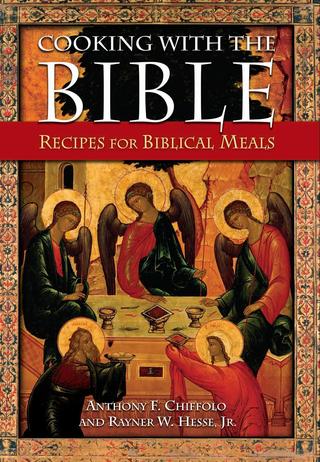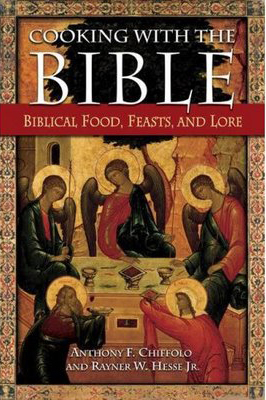Cooking with the Bible
Cooking with the Bible: Recipes for Biblical Meals provides a feast for the body, mind, and spirit, introducing contemporary cooks to recipes for eighteen meals described in the Judeo-Christian bible. Each chapter begins with the menu for a biblical feast, followed by a brief essay describing the theological, historical, and cultural significance of the feast. Next are separate recipes for the dishes served in the meal, followed by more commentary on the dish itself, preparation methods used in biblical times, and how the dish was served.
Since biblical times, the Judeo-Christian lifestyle has centered on meals. Extending hospitality to both friends and strangers was a divine command, and an invitation to dine was sacred. The Judeo-Christian bible is peppered with stories of meals; these range from simple meals put together quickly in order to feed a few unexpected guests, to elaborate feasts carefully prepared to please dozens of partygoers for many days. Cooking with the Bible looks at eighteen of these meals found in the Scriptures, providing full menus and recipes for re-creating some of the dishes enjoyed by the peoples of biblical times. While describing how ancient cooks prepared their foods, Cooking with the Bible also explains how contemporary cooks might use modern techniques and appliances to prepare each of the eighteen meals. To set the scene for each meal, the book examines the scriptural text in detail, describes the backstory for each, and, in the process, traces Judeo-Christian history from the ancient city of Ur to the lands of Egypt to the holy city of Jerusalem. Along the way, the reader will learn about the history of the bible itself. In the Middle East, eating was not and is not for daily sustenance alone―it is a way of life, and Cooking with the Bible reflects that reality, providing multiple feasts for the body, mind, and spirit. More information is available at: www.cookingwiththebible.com.
Each chapter begins with the menu for a biblical feast. A brief essay describing the theological, historical, and cultural significance of the feast follows. Next come separate recipes for the dishes served in the meal, followed by more commentary on the dish itself, preparation methods used in biblical times, and how the dish was served. Recipes for a wide variety of breads, stews, rice and lentil dishes, lamb, goat, fish and venison meals, vegetable salads and cakes are detailed, all of them carefully tested. Make delicious dishes such as Rice of Beersheba, Rebekah's Tasty Lamb Stew, Date and Walnut Bread, Ful Madames and Scrambled Eggs, Pistachio Crusted Sole, Bamya, Goat's Milk and Pomegranate Syrup Torte, Haroset a la Greque, Pesach Black Bread, Watermelon Soup with Ginger and Mint, Date Manna Bread, Oven-baked Perch with Tahini, Braided Challah with Poppy Seeds and Lemon, and Friendship Cake.
You can find out more about Cooking with the Bible here: http://www.cookingwiththebible.com.
Co-author Rayner W. Hesse, Jr. is a retired Episcopal priest serving parishes on the Delaware and Maryland shores. He is also the author of Jewelrymaking through History: An Encyclopedia.


The hardcover edition includes an appendix that recounts the lore of all the ingredients used in the book, detailing their origins, the history of their cultivation, their nutritional value, and their various uses.